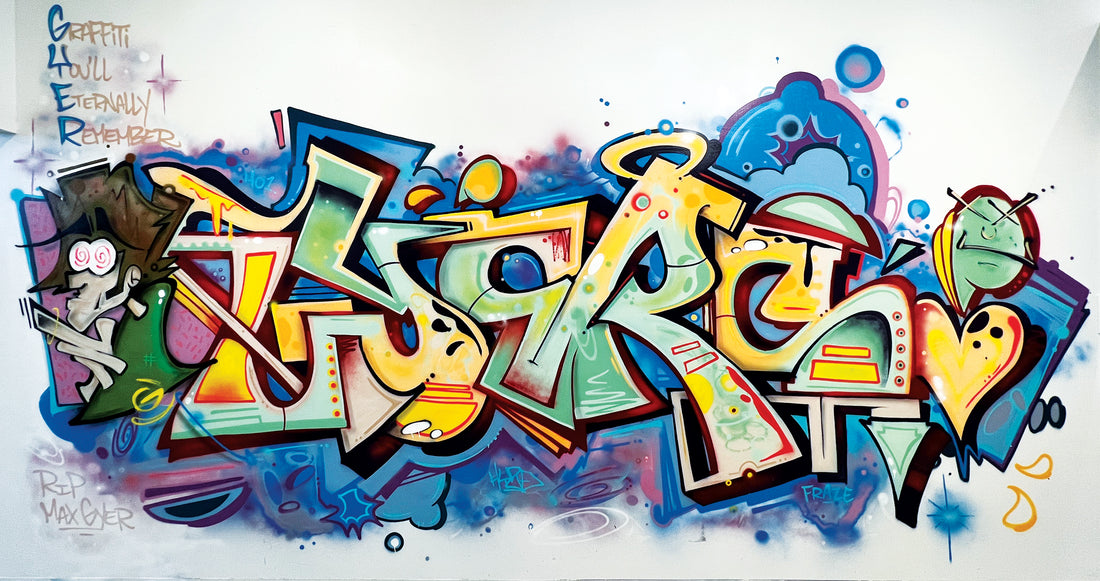When looking at graffiti, for quite some time, many people have debated over whether or not the colorful designs should qualify as art. Although the answer seems pretty clear to us, to truly answer the question, take a closer look at what exactly Graffiti is and if it is indeed art.
What is Graffiti? Is it Art?
What is graffiti, and should it be considered art? These questions can be answered by looking back at the history of graffiti and how it came to be.
Etymology, the study of the origin of words, can often be incredibly telling, and that is the case for the sometimes controversial term "graffiti." Graffiti stems from the Italian term graffito, meaning to scratch or scribble. This makes sense considering the history behind graffiti.
The History of Graffiti
There is no arguing that graffiti art is, rightfully so, on the rise, but graffiti has been around for quite some time. The earliest forms of graffiti can be traced back to the ruins of Pompeii and the 20,000-year-old paintings located in France's Lascaux Cave.
During World War II, American soldiers used graffiti overseas to create the infamous and well-known cartoon man with the phrase "Kilroy Was Here." The graffiti not only allowed troops to know the Americans were here and left their mark but also served as a sense of camaraderie during the trying and tough times. Over time, graffiti and the views surrounding it shifted and changed.
During the 1960s, graffiti would undergo a revolution and movement like no other. Some say it began in 1967 in North Philadelphia with a young man named Darryl McCray, known as Cornbread. Through his tagging name Cornbread, McCray became the talk of the town. Cornbread was everywhere in Philadelphia, from trying to win over his crush, Cynthia, to being featured in local newspaper articles.
By the early 1970s, the graffiti movement had fully engulfed New York City, and the momentum was undoubtedly building–now with artists competing for the best public spots and to introduce novel letter styles. Flash forward five decades later, and graffiti artists are now being celebrated in museums and taking on highly-deserved commercial space. Futura and Barry McGee are two examples of that, and speaking of the people behind graffiti art, let's take a closer look at tagging.
What is tagging?
In the world of graffiti, tagging refers to any word, name, or term that is consistently repeated. It is the artist's signature and represents their identity in many ways. When it comes to tagging, especially in today's technologically advanced ways, there are many different styles that artists can use. From simple tags to incorporating tag styles into intricate murals, there are many different ways that this can be done.
For McCray, his tag, of course, was Cornbread. In other cases, like Ghost, his fans and followers only know his tag since the artist keeps his real identity hidden.
Popular themes that appear in Graffiti
More often than not, letter mastery and design is an underlying theme in graffiti artists' work. From developing new styles to modifying old ones, this can come presented in many different ways. Wild-style, mechanical, and block letters are a few popular letter styles that graffiti artists often work with.
Experiences the Museum of Graffiti has to offer
There is no doubt that the rich, complex, and connected history of graffiti contributes to its art form. Fortunately, the Museum of Graffiti has some amazing experiences and exhibits celebrating the work and people behind the culture and art that can be found in cities all over the world.
One of our museum's current exhibits, The Wide World Of Graffiti, takes viewers on a journey around the globe while looking at some of the most highly-talked-about artists and trendsetters. Enjoy partaking in graffiti's past, present, and future.
For fans who can appreciate animation and fan-favorite book characters, the Influenced by Comics exhibit is another must-see. The All Black Everything exhibit highlights the fantasy and imaginative elements black artists were using, specifically during the 1970s in the Bronx. Dubbed the first comprehensive survey of African American graffiti art, this is an exhibit you won't want to miss.
In addition to the compelling exhibits, the Museum of Graffiti hosts many community-based events. Spray it Loud, a graffiti class for beginners, and Kids' Graffiti Drawing Class are just two of the amazing opportunities offered by the Museum of Graffiti.
Last, when you visit the Museum’s gift shop, you can find rare items by Banksy, Osgemeos, Kaws, and more!
Image Credit: Museum of Graffiti

